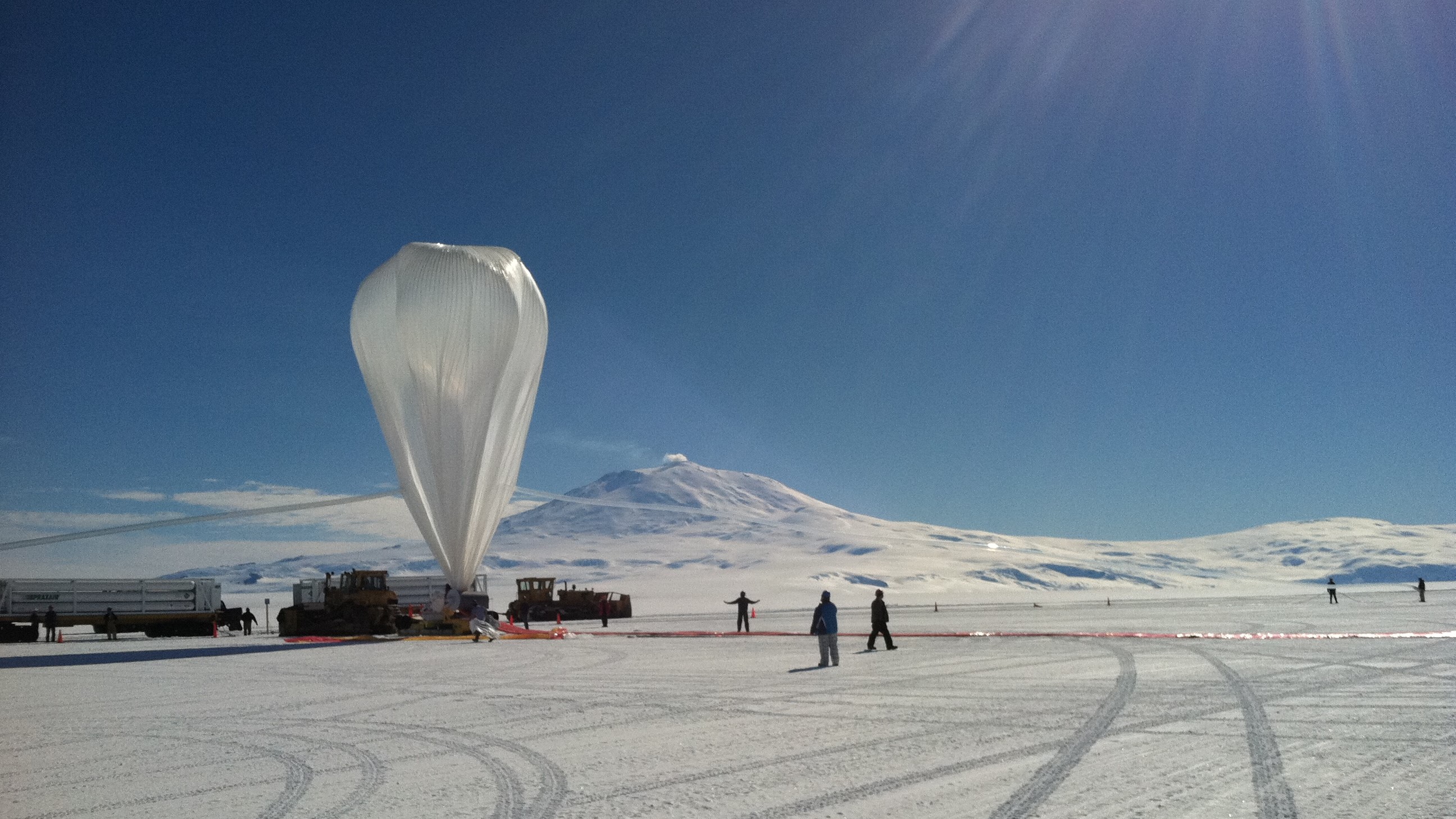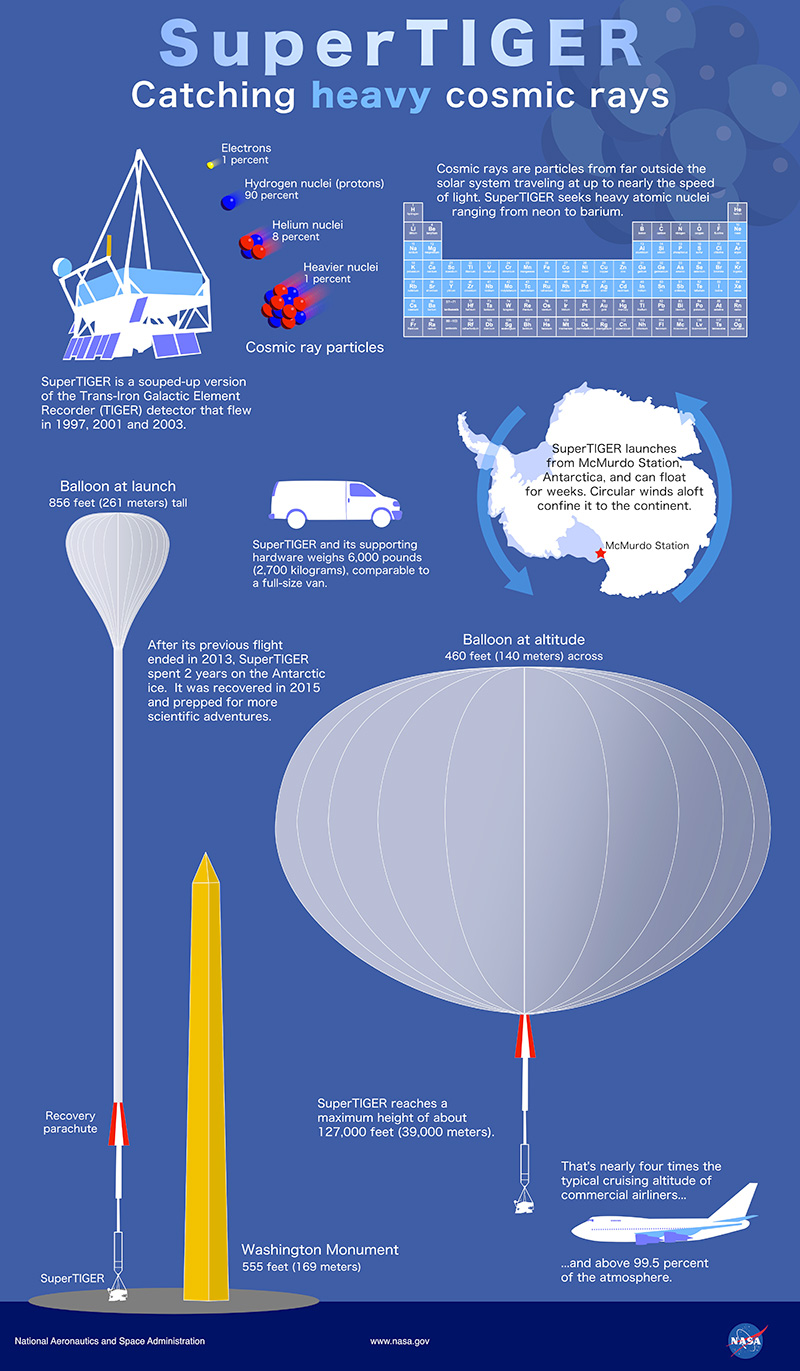What are cosmic rays?
Cosmic rays rain down on Earth, but where do they come from?

Cosmic rays are atom fragments that rain down on the Earth from outside of the solar system. They blaze at nearly the speed of light and have been blamed for electronic problems in satellites and other machinery.
Discovered in 1912, many things about cosmic rays remain a mystery more than a century later. One prime example is exactly where they are coming from. Most scientists suspect their origins are related to supernovas (star explosions), but the challenge is that cosmic ray origins appeared uniform to observatories examining the entire sky for many years.
A significant leap forward in cosmic ray science came in 2017 when the Pierre Auger Observatory (which is spread over 3,000 square kilometers, or 1,160 square miles, in western Argentina) studied the arrival trajectories of 30,000 cosmic particles. It concluded that there is a difference in how frequently these cosmic rays arrive, depending on where you look. While their origins are still nebulous, knowing where to look is the first step in learning where they came from, the researchers said. The results were published in Science.
Cosmic rays can even be used for applications outside of astronomy. In November 2017, a research team discovered a possible void in the Great Pyramid of Giza, which was built around 2560 B.C., using cosmic rays. The researchers found this cavity using muon tomography, which examines cosmic rays and their penetrations through solid objects.
Discovery of cosmic rays
While cosmic rays were only discovered in the 1900s, scientists knew something mysterious was going on as early as the 1780s. That's when French physicist Charles-Augustin de Coulomb — best known for having a unit of electrical charge named after him — observed an electrically charged sphere suddenly and mysteriously not being charged anymore.
At the time, air was thought to be an insulator and not an electric conductor. With more work, however, scientists discovered that air can conduct electricity if its molecules are charged or ionized. This would most commonly happen when the molecules interact with charged particles or X-rays.
But where these charged particles came from was a mystery; even attempts to block the charge with large amounts of lead were coming up empty. On Aug. 7, 1912, physicist Victor Hess flew a high-altitude balloon to 17,400 feet (5,300 meters). He discovered three times more ionizing radiation there than on the ground, meaning the radiation had to come from outer space.
Breaking space news, the latest updates on rocket launches, skywatching events and more!
But tracing cosmic ray "origin stories" took more than a century. In 2013, NASA's Fermi Gamma-ray Space Telescope released results from observing two supernova remnants in the Milky Way: IC 433 and W44.
Among the products of these star explosions are gamma-ray photons, which (unlike cosmic rays) are not affected by magnetic fields. The gamma rays studied had the same energy signature as subatomic particles called neutral pions. Pions are produced when protons get stuck in a magnetic field inside the supernova's shockwave and crash into each other.
In other words, the matching energy signatures showed that protons could move at fast enough speeds within supernovas to create cosmic rays.
Cosmic rays FAQs answered by an expert
We asked Justin Vandenbroucke, an associate professor in the Department of Physics and Wisconsin IceCube Particle Astrophysics Center at the University of Wisconsin–Madison a few frequently asked questions about cosmic rays.

Associate professor in the Department of Physics and Wisconsin IceCube Particle Astrophysics Center at the University of Wisconsin–Madison
What are cosmic rays?
Cosmic rays are energetic subatomic particles produced by naturally occurring particle accelerators in outer space. They span a huge range in energies and a variety of types of particles. Strictly speaking, they are charged particles (electrons, protons, and atomic nuclei), although there are also cosmic neutral particles (photons and neutrinos) that are closely related.
The highest energy cosmic rays have as much kinetic energy as a fast thrown baseball, all in a single subatomic particle! This is tens of millions of times more energy than has been reached in human-constructed particle accelerators. Most cosmic rays, especially at the low energy range, are single protons. But many are complete atomic nuclei (clusters of protons and neutrons) spanning a wide range of the period table.
Where do cosmic rays come from?
This is a question physicists and astronomers have been working hard to answer ever since cosmic rays were discovered in the early 1900s.
Many, particularly at low energies, are produced by the sun. At higher energies, the origins of cosmic rays remain a subject of active research. There is strong evidence that some are produced in our own galaxy (the Milky Way) in supernova remnants (the slowly decelerating aftermath of a star exploding, causing its material to plow through the surrounding space, which has low density but is not a completely empty vacuum).
At the highest energies, cosmic rays likely originate outside our galaxy, in even more energetic environments such as the surroundings of giant black holes at the center of distant galaxies. Continuing to identify the multiple origins of cosmic rays will help us to understand these most extreme parts of the universe and also to use these naturally occurring particle accelerators and the particles they produce to answer fundamental physics questions.
What happens when cosmic rays hit the Earth?
When a single energetic cosmic ray hits the Earth, it typically interacts high in Earth's atmosphere, undergoing a particle physics reaction with an atom of air, shattering the atom. The outgoing shards of the atom are often energetic enough to in turn shatter additional atoms, and so on.
In this way, a shower of energetic subatomic particles develops. A small fraction of the particles in this shower can reach ground level and collide with atoms there. These secondary subatomic particles, produced as part of the shower in Earth's atmosphere, are sometimes grouped together with the ones that arrive at Earth directly from astrophysical sources and together called cosmic rays.
Are cosmic rays harmful?
Cosmic rays are one type of ionizing radiation, meaning they are energetic enough to knock electrons out of atoms, ionizing them. If the atom is part of electronics or computing equipment, this can change the performance of the electronics or cause a one-time error in a computer. If the atom is part of a living being, perhaps part of a DNA molecule, it can damage the biological tissue, perhaps causing a mutation in the DNA.
Cosmic rays are therefore part of the naturally occurring radiation dose that people receive throughout their lives. Because Earth's atmosphere absorbs most of the energy of cosmic rays, only a small fraction reaches ground level. Earth's magnetic field also deflects many of the original primary cosmic rays before they reach the atmosphere, providing further protection.
Cosmic rays, therefore, contribute a small fraction of the total radiation dose people receive, smaller than that due to naturally occurring xenon from radioactive isotopes in Earth's crust, for example. Moreover, both computing equipment and biological tissue can identify and correct the errors caused by ionizing radiation much of the time. In situations where neither the atmosphere nor Earth's magnetic field can shield people from cosmic rays, such as on a long flight to Mars, the radiation dose from cosmic rays is a larger cause for concern.
Current understanding of cosmic rays
We know today that galactic cosmic rays are atom fragments such as protons (positively charged particles), electrons (negatively charged particles) and atomic nuclei. While we know now they can be created in supernovas, there may be other sources available for cosmic ray creation. It also isn't clear exactly how supernovas are able to make these cosmic rays so fast.
Cosmic rays constantly rain down on Earth, and while the high-energy "primary" rays collide with atoms in the Earth's upper atmosphere and rarely make it through to the ground, "secondary" particles are ejected from this collision and do reach us on the ground.
But by the time these cosmic rays get to Earth, it's impossible to trace where they came from. That's because their path has been changed as they traveled through multiple magnetic fields (the Milky Way's, the solar system's and Earth's itself.)
Scientists are trying to trace back cosmic ray origins by looking at what the cosmic rays are made of. They can figure this out by looking at the spectroscopic signature each nucleus gives off in radiation, and also by weighing the different isotopes (types) of elements that hit cosmic ray detectors.
The result, NASA adds, shows very common elements in the universe. Roughly 90 percent of cosmic ray nuclei are hydrogen (protons) and 9 percent are helium (alpha particles). Hydrogen and helium are the most abundant elements in the universe and the origin point for stars, galaxies and other large structures. The remaining 1 percent are all elements, and it's from that 1 percent that scientists can best search for rare elements to make comparisons between different types of cosmic rays. The Pierre Auger Observatory collaboration found some variations in the arrival trajectories of cosmic rays in 2017, providing some hints about where the rays could have originated.
Scientists can also date the cosmic rays by looking at radioactive nuclei that decrease over time. Measuring the half-life of each nuclei gives an estimate of how long the cosmic ray has been out there in space.
In 2016, a NASA spacecraft found most cosmic rays likely come from (relatively) nearby clusters of massive stars. The agency's Advanced Composition Explorer (ACE) spacecraft detected cosmic rays with a radioactive form of iron known as iron-60. Since this form of cosmic ray degrades over time, scientists estimate it must have originated no more than 3,000 light-years from Earth — the equivalent distance of the Milky Way's local spiral arm's width.
An experiment called ISS-CREAM (Cosmic Ray Energetics and Mass) was launched to the International Space Station in 2017. It was expected to operate for three years, answering questions such as whether supernovas generate the most cosmic ray particles, when cosmic ray particles originated, and if all the energy spectra seen for cosmic rays can be explained by a single mechanism. But in February 2019, NASA pulled the plug on the experiment. The premature shutdown of ISS-CREAM came after a majority of scientists involved in the project rejected NASA's demand to replace the project's principal investigator (PI), University of Maryland (UMD) physicist Eun-Suk Seo, with the agency’s hand-picked successor, according to an article published in Physics Today.
The ISS also hosts the CALorimetric Electron Telescope (CALET), which searches for the highest-energy types of cosmic rays. CALET was launched there in 2015.
Cosmic rays can also be detected by balloon, such as through the Super Trans-Iron Galactic Element Recorder (SuperTIGER) experiment that includes participation from NASA's Jet Propulsion Laboratory and several universities. It flew several times, including a record 55-day flight over Antarctica between December 2012 and January 2013. "With the data from this flight we are studying the origin of cosmic rays. Specifically, testing the emerging model of cosmic-ray origins in OB associations, as well as models for determining which particles will be accelerated," the SuperTIGER website said.
Then in December 2019, SuperTIGER 2:0 took to the skies. The second flight of the SuperTIGER cosmic ray experiment, officially named SuperTIGER-II flew above Antarctica for over a month, collecting valuable cosmic ray data.
Citizen scientists can also participate in the search for cosmic rays by registering at the website crayfis.io. There, they will join the CRAYFIS experiment run by the Laboratory of Methods for Big Data Analysis (LAMBDA) at the National Research University Higher School of Economics in Russia. Researchers there are examining ultra-high energy cosmic rays using mobile phones.
Another citizen science project called DECO (the Distributed Electronic Cosmic-ray Observatory) also uses mobile phones to help collect data on cosmic rays. This app works by recording a camera image, once every 1-2 seconds then the app analyzes the image to determine bright pixels and whether the sample image represents a high-energy particle interaction.
Are cosmic rays dangerous?
Earth's magnetic field and atmosphere shields the planet from 99.9 percent of the radiation from space. However, for people outside the protection of Earth's magnetic field, space radiation becomes a serious hazard.
An instrument aboard the Curiosity Mars rover during its 253-day cruise to Mars revealed that the radiation dose received by an astronaut on even the shortest Earth-Mars round trip would be about 0.66 sieverts. This amount is like receiving a whole-body CT scan every five or six days.
A dose of 1 sievert is associated with a 5.5 percent increase in the risk of fatal cancers. The normal daily radiation dose received by the average person living on Earth is 10 microsieverts (0.00001 sieverts).
The moon has no atmosphere and a very weak magnetic field. Astronauts living there would have to provide their own protection, for example by burying their habitat underground.
Mars has no global magnetic field. Particles from the sun have stripped away most of Mars' atmosphere, resulting in very poor protection against radiation at the surface. The highest air pressure on Mars is equal to an altitude of 22 miles (35 kilometers) above the Earth's surface. At low altitudes, Mars' atmosphere provides slightly better protection from space radiation.
In 2017, NASA made some upgrades to its Space Radiation Laboratory (located at the Brookhaven National Laboratory in New York) to do more studies into how cosmic rays may affect astronauts on long voyages, including to Mars. These upgrades allow researchers to alter the types of ions, and the intensity of energy, more easily due to software control.

Elizabeth Howell (she/her), Ph.D., was a staff writer in the spaceflight channel between 2022 and 2024 specializing in Canadian space news. She was contributing writer for Space.com for 10 years from 2012 to 2024. Elizabeth's reporting includes multiple exclusives with the White House, leading world coverage about a lost-and-found space tomato on the International Space Station, witnessing five human spaceflight launches on two continents, flying parabolic, working inside a spacesuit, and participating in a simulated Mars mission. Her latest book, "Why Am I Taller?" (ECW Press, 2022) is co-written with astronaut Dave Williams.


